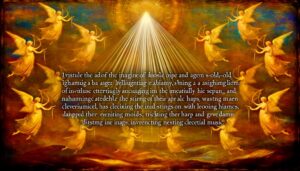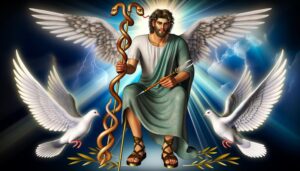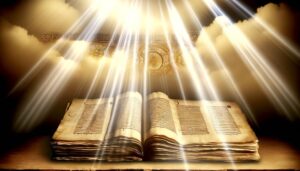Tammuz Meaning in the Bible: Pagan Worship and Idolatry
In the Bible, Tammuz is primarily mentioned in Ezekiel 8:14, where the prophet Ezekiel witnesses women mourning for Tammuz at the temple, a practice indicating the Israelites’ syncretism and idolatry. This scene critiques the adoption of foreign deities into Israelite worship, which deviated from exclusive devotion to Yahweh.
Originating from Mesopotamian mythology, Tammuz (Dumuzi) was a fertility god symbolizing agricultural cycles and seasonal rebirth. His incorporation into the Israelite religious practice exemplifies significant cultural and theological tensions.
The detailed critique unfolds layers of historical and cultural blending that deeply influenced religious identity. Explore further to understand his multifaceted role.
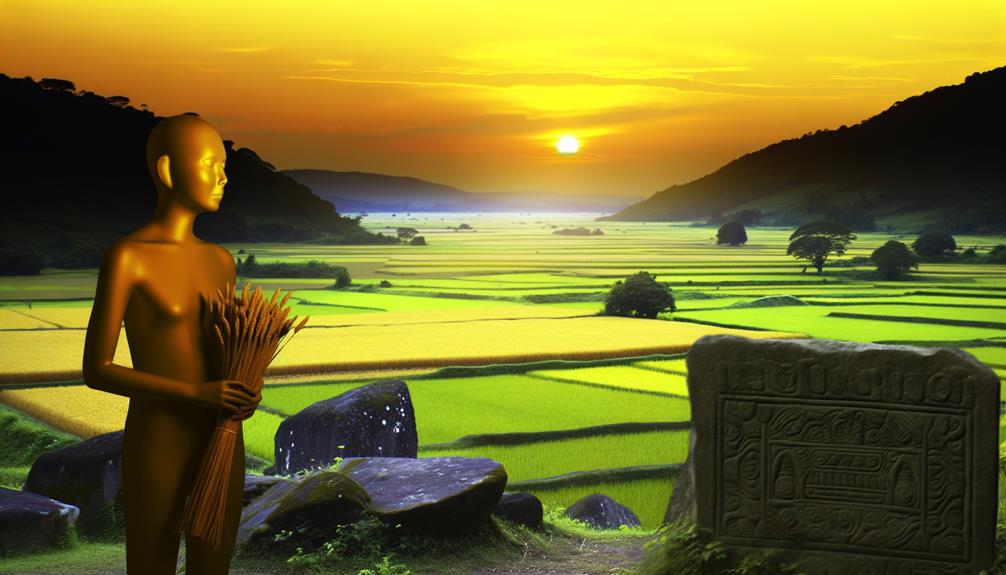
Tammuz Meaning in the Bible: Pagan Worship and Spiritual Apostasy
| Biblical Reference | Meaning | Symbolism | Spiritual Insight |
|---|---|---|---|
| Ezekiel 8:14 | Pagan Idol Worship | Women weeping for Tammuz | Sign of Israel’s deep spiritual corruption |
| Historical Context | Babylonian Fertility Deity | Death and resurrection cycle | Represents false hope in man-made gods |
| Related Pagan Practice | Seasonal Mourning Rituals | Weeping over the god’s death | Reflects emotional deception of idolatry |
| Contrast in Scripture | True Worship vs. Idolatry | God vs. foreign gods | Highlights the need for exclusive devotion |
| Spiritual Lesson | Warning Against Apostasy | Turning hearts away from God | Urges faithfulness to the true God alone |
Biblical Reference to Tammuz
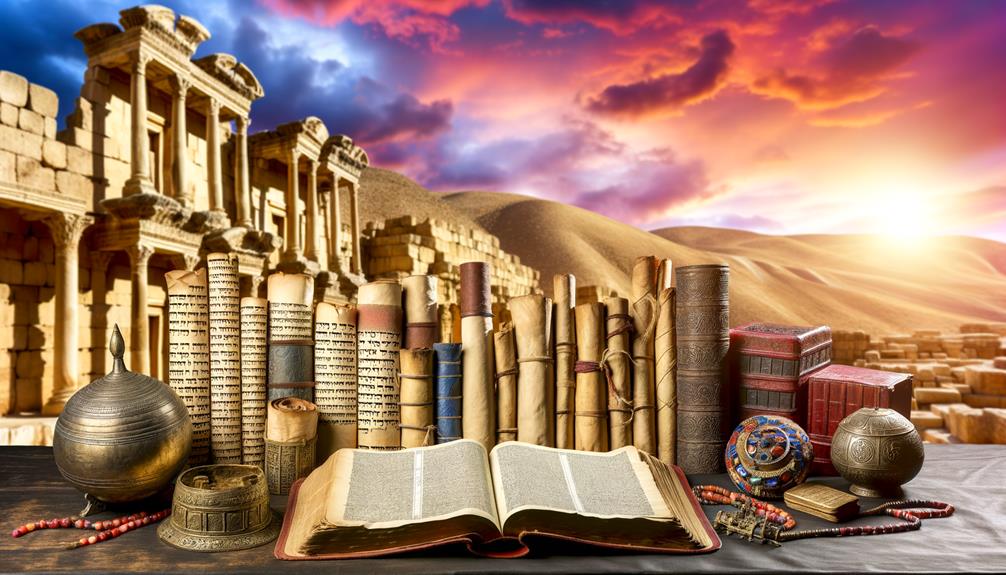
The biblical reference to Tammuz is found primarily in the Book of Ezekiel, where the prophet Ezekiel describes a vision of women weeping for Tammuz at the entrance of the north gate of the temple in Jerusalem.
This scene, depicted in Ezekiel 8:14, is significant as it highlights the syncretism and idolatry present among the Israelite people during that period.
The mourning for Tammuz, a Mesopotamian fertility god associated with seasonal cycles, underscores the infiltration of foreign religious practices into Hebrew worship.
Ezekiel’s vision serves as a critique of the Israelites’ deviation from monotheistic worship, illustrating the broader theme of spiritual infidelity.
This reference therefore provides essential insight into the religious dynamics and cultural exchanges of ancient Israel.
Historical Background of Tammuz
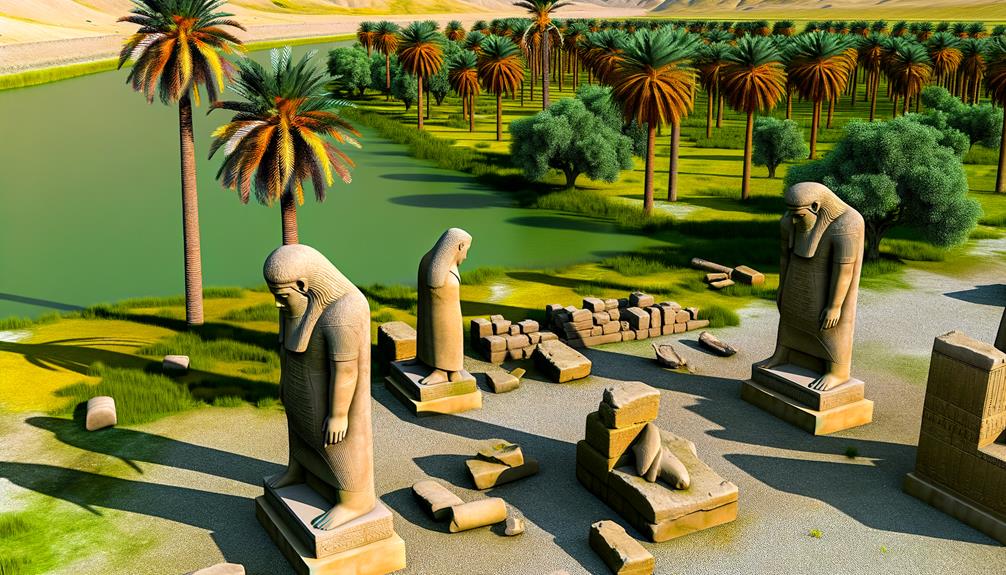
Originating in ancient Mesopotamian mythology, Tammuz is a deity whose worship can be traced back to the early Sumerian period, where he was venerated as Dumuzi, the god of fertility and shepherds.
The cult of Dumuzi/Tammuz played a significant role in agricultural societies, symbolizing the annual cycle of death and rebirth linked to the seasons. His narrative of descent into the underworld and subsequent return was emblematic of the natural world’s regenerative processes.
Tammuz’s mythological significance was perpetuated through intricate religious rituals, including lamentations performed by priestesses. These rituals underscored the socio-religious importance of Tammuz, reflecting the interdependence between human livelihood and natural cycles.
This historical background lays the foundation for understanding Tammuz’s integration into later cultural and religious contexts.
Tammuz in Near Eastern Religions
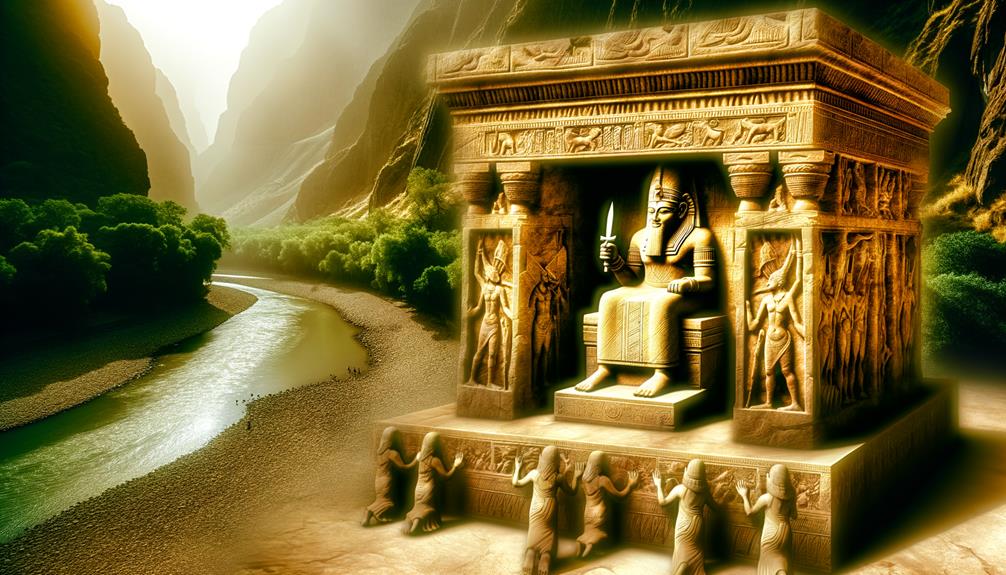
Tammuz, also known as Dumuzi in Sumerian mythology, plays a critical role in Near Eastern religions, symbolizing themes of death and rebirth.
His mythological narrative is intricately tied to agricultural cycles, where his descent into the underworld and subsequent return are commemorated through seasonal festivals and rites.
These rituals not only celebrate the cyclical nature of life and death but also underscore Tammuz’s significance as a deity who bridges mortal existence and divine renewal.
Tammuz’s Role in Mythology
In the intricate tapestry of Near Eastern religions, Tammuz occupies a multifaceted role as a deity associated with fertility, agriculture, and the cycle of life and death.
Revered primarily in Sumerian, Akkadian, and Babylonian traditions, Tammuz’s mythology underscores his significance in maintaining cosmic and terrestrial balance. His narrative often involves a descent to the underworld, symbolizing the seasonal death and rebirth integral to agricultural societies.
Tammuz’s mythological framework is rich with allegorical elements that reflect human existential concerns and natural phenomena.
- Descent to the Underworld: Represents the seasonal cycle of death and rebirth.
- Fertility Symbol: Embodies agricultural abundance and human procreation.
This analysis elucidates Tammuz’s enduring legacy in mythological contexts.
Seasonal Festivals and Rites
Seasonal festivals and rites dedicated to Tammuz in Near Eastern religions intricately wove together agricultural practices, communal rituals, and cosmological beliefs to honor the deity’s influence on fertility and renewal. These observances often coincided with the summer solstice, marking a critical period in the agricultural calendar.
Rituals included lamentations and ceremonial mourning, reflecting the land’s temporary barrenness. Communities engaged in processions, offerings, and recitations of hymns to invoke Tammuz’s blessings for agricultural bounty.
These rites also facilitated social cohesion, reinforcing shared cosmological narratives about the cyclical nature of life and growth. The integration of these practices underscored a profound connection between human activities, environmental rhythms, and divine favor, illustrating Tammuz’s pivotal role in sustaining agrarian life.
Symbolism of Death and Rebirth
Rooted in the cyclical agricultural patterns of the Near East, the symbolism of death and rebirth surrounding Tammuz reveals profound insights into ancient conceptions of life’s impermanence and renewal. Tammuz, often associated with the seasonal cycle of vegetation, mirrors the dying and reviving earth.
This reflects a broader theological and mythological framework where the deity’s death marks the decline of fertility, while his return heralds rejuvenation. Such narratives underscore the interconnectedness of cosmic and human experiences, emphasizing continuity amidst change.
Tammuz’s death signifies the summer solstice and the decline in agricultural productivity. His rebirth symbolizes the return of fertility and the renewal of life.
Rituals and festivals in his honor reflect communal acknowledgment of these cyclical processes. This analysis highlights the enduring relevance of Tammuz in understanding ancient Near Eastern cosmology.
Tammuz and Fertility Rites
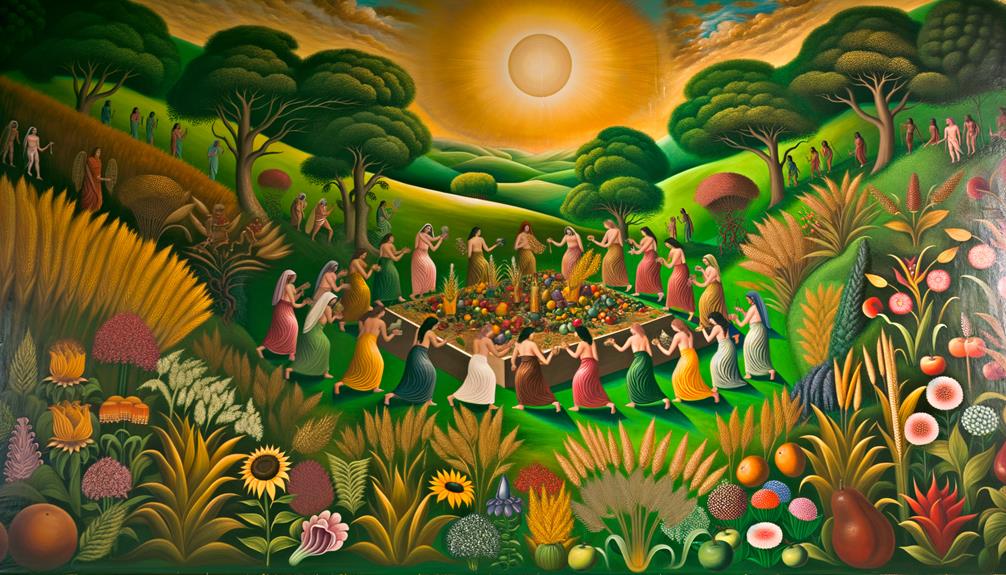
Tammuz, a deity deeply associated with fertility rites in ancient Mesopotamian cultures, is often depicted in the Bible as a symbol of agricultural cycles and renewal.
The worship of Tammuz involved ritualistic practices aimed at ensuring the fertility of the land and the prosperity of crops. These rites frequently included lamentations and ceremonial mourning, reflecting Tammuz’s mythological descent into the underworld and subsequent return, symbolizing the death and rebirth of vegetation.
Such practices were integral to agrarian societies, underscoring the cyclical nature of seasons.
The biblical references, especially in Ezekiel 8:14, highlight the infiltration of these rites into Israelite worship, illustrating the cultural and religious exchanges between neighboring civilizations and the resultant theological implications.
Syncretism in Israelite Worship
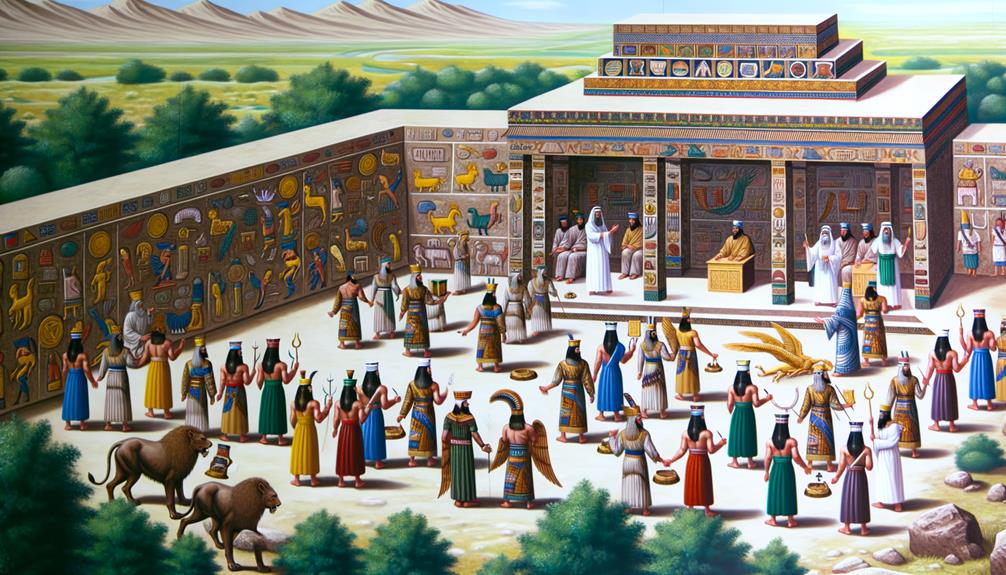
The phenomenon of syncretism in Israelite worship is evidenced by the incorporation of foreign deities and religious practices into the traditional Yahwistic framework, reflecting a complex interplay of cultural and theological influences.
This amalgamation often resulted from Israel’s interactions with neighboring civilizations, leading to the blending of diverse religious elements. Tammuz, a Mesopotamian deity linked to agriculture and fertility, is one such example of a foreign influence that permeated Israelite worship practices.
- Cultural Exchange: Israel’s proximity to and interactions with Mesopotamian societies facilitated religious and cultural exchanges.
- Archaeological Evidence: Artifacts and inscriptions reveal the presence of foreign deities in Israelite religious contexts.
Theological Implications of Tammuz
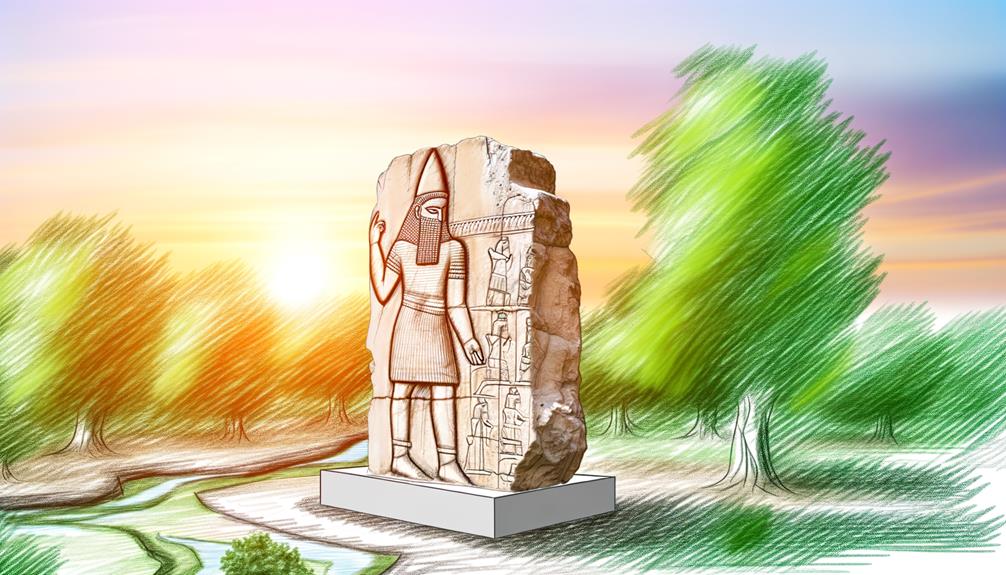
Examining the theological implications of Tammuz’s integration into Israelite worship reveals a significant departure from monotheistic principles, highlighting the tensions and contradictions within the community’s religious identity. This syncretism undermined the core doctrine of Yahweh’s singular divinity, introducing a polytheistic element into the spiritual fabric of Israel. The worship of Tammuz, a fertility deity, clashed with the prophetic calls for exclusive devotion to Yahweh, as seen in texts like Ezekiel 8:14.
| Aspect | Israelite Worship | Tammuz Worship |
|---|---|---|
| Core Deity | Yahweh | Tammuz |
| Theological Focus | Monotheism | Polytheism |
| Ritual Practices | Sacrifices, Festivals | Mourning, Fertility Rites |
| Scriptural Opposition | Prophetic Writings | Pagan Traditions |
| Religious Identity | Exclusive Devotion | Syncretic Practices |
This integration prompted theological debates about purity, faithfulness, and religious identity.
Tammuz’s Legacy in Modern Contexts

Tammuz’s enduring influence is evident in contemporary cultural references, where he frequently appears in modern literature and media, symbolizing themes of death and rebirth.
Additionally, his legacy persists in religious symbolism today, particularly within neo-pagan and revivalist traditions that reinterpret ancient myths.
Examining these manifestations provides insight into how ancient narratives continue to shape modern identity and spiritual practices.
Contemporary Cultural References
In contemporary culture, the legacy of Tammuz is evident through various artistic, literary, and religious expressions that continue to draw from his ancient mythological significance. Modern interpretations often weave his narrative into broader themes of life, death, and rebirth, providing a rich tapestry for creative exploration.
- Literature: Tammuz is referenced in numerous works of fiction and poetry, symbolizing the perennial cycle of seasons and human emotions.
- Visual Arts: His imagery and mythology inspire contemporary artworks, from paintings to sculptures, reflecting the enduring power of ancient narratives.
- Popular Media: Tammuz’s story appears in films, television series, and video games, often reimagined to fit modern storytelling contexts.
These manifestations underscore Tammuz’s lasting impact on contemporary culture.
Religious Symbolism Today
The enduring presence of Tammuz’s mythology in contemporary culture invites a closer examination of his religious symbolism and its resonance within modern spiritual practices and beliefs.
Tammuz, as a deity associated with fertility, death, and rebirth, continues to be a potent symbol in various neo-pagan and syncretic traditions. His cyclical journey of descent and return mirrors themes of personal transformation and renewal, which are celebrated in rituals aiming to connect practitioners with the rhythms of nature.
Additionally, Tammuz’s influence extends to spiritual discourses on the balance between masculine and feminine energies, reflecting his dualistic nature.
This ongoing relevance underscores the adaptability of ancient myths, allowing Tammuz to maintain a significant, albeit evolving, presence in contemporary religious thought and practice.
Tammuz in Literature
Exploring Tammuz’s legacy in modern literature reveals a nuanced interplay between ancient mythological themes and contemporary narrative forms. Tammuz, the Mesopotamian deity symbolizing death and rebirth, has inspired a wealth of literary exploration. Authors often weave his story into broader themes of transformation and cyclical existence, reflecting modern existential inquiries.
- Symbolism in Modern Poetry: Tammuz’s tale is employed to evoke themes of loss and renewal, enriching poetic metaphors.
- Influence on Fiction: Contemporary novels use Tammuz as a narrative device to explore human resilience and the inevitability of change.
- Academic Discourse: Scholarly works analyze Tammuz’s mythological significance, examining its reinterpretation in modern contexts to understand cultural continuity and adaptation.
This literary engagement underscores Tammuz’s enduring relevance.
Conclusion
The multifaceted legacy of Tammuz, entwined with ancient fertility rites and Near Eastern religious practices, reveals a complex tapestry of syncretism within Israelite worship.
This figure’s presence in biblical texts underscores the theological implications of adopting external deities.
As a thread in the broader historical and religious fabric, Tammuz serves as a poignant reminder of the perennial tension between cultural integration and religious orthodoxy, echoing through the corridors of both ancient and modern spiritual landscapes.


